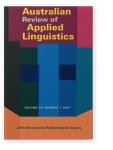Anxiety and oral performance in a foreign language test situation
This research investigates a situation specific anxiety: oral examination anxiety in a foreign language learning situation. It examines how a particular type of language anxiety - anxiety in oral communication - impacts on the learner’s oral performance. The subjects are first year Japanese language students at tertiary level in Australia. Questionnaire surveys were conducted to measure the students’: a) anxiety in foreign language classes, b) their anxiety toward oral examinations, and c) the anxiety they actually felt in an oral examination. The objectives of the study were to investigate relations between anxiety and scores in oral examinations. The results indicated that state anxiety can be a strong predictor of learners’ performance in an examination. However, the subjects’ trait anxiety had also both direct and indirect influence over their oral performance. A cause-effect relation among trait anxiety, oral performance, and state anxiety (MacIntyre and Gardner 1989) was also observed in this study.
References (27)
Cattell, R. B. and I. H. Scheier
(
1961)
The meaning and measurement of meuroticism and anxiety. New York, Ronald Press.

Chastain, K.
(
1975)
Affective and ability factors in second language acquisition.
Language Learning 251, 153–161.


Deffenbacher, J. L.
(
1980)
Worry and emotionality in test anxiety. In
I. G. Sarason (ed),
Test anxiety: theory, research, and applications. Hillsdale, N. J., Lawrence Erlbaum Associates, Publishers..

Eysenck, M. W.
(
1997)
Anxiety and cognition: A unified theory. Hove, Sussex, Psychological Press Ltd.

Horwitz, E. K.
(
1983)
Foreign language classroom anxiety scale. Unpublished manuscript.

Horwitz, E. K., M. B. Horwitz, and J. Cope
(
1986)
Foreign language classroom anxiety, Modern Language Journal 701, 125–132.

Horwitz, E. K.
(
1991)
Preliminary evidence for the reliability and validity of a foreign language anxiety scale. In
E. K. Horwitz and
D. Young (eds),
Language anxiety: From theory and research to classroom implication., Englewood Cliffs, N. J., Prentice-Hall.

Kleinmann, H. H.
(
1977)
Avoidance behaviour in adult second language acquisition.
Language Learning, 271, 93–107.


MacIntyre, P. D. and R. C. Gardner
(
1994)
The effects of induced anxiety on three stages of cognitive processing in computerised vocabulary learning,
Studies in Second language Acquisition 161, 1–17.


MacIntyre, P. D. and R. C. Gardner
(
1991)
Method and results in the study of anxiety and language learning: A review of the literature.
Language learning 411, 85–117.


MacIntyre, P. D. and R. C. Gardner
(
1989)
Anxiety and second language learning: Toward a theoretical clarification.
Language learning 391, 251–275.


Matthew, T.
(
1977)
The effects on item working on item characteristics on the state-trait anxiety inventory and the state- trait curiosity inventory. Unpublished M.Ed. thesis, University of Melbourne.

Parkinson, B.
(
1995)
Ideas and realities of emotion. London, Routledge.

Phillips, E. M.
(
1992)
The effects of language anxiety on students’ oral test performance and attitudes.
The Modern Language Journal, 761, 14–26.


Sarason, I. G.
(
1961)
Test anxiety and intellectual performance of college students.
Journal of Educational Psycholoty 521, 201–206.


Sarason, I. G.
(
1972a)
Experimental approaches to test anxiety: Attention and the uses of information. In
D. C. Spielberger (ed),
Anxiety: Current trends in theory and research (Vol. 21). New York, Academic Press.


Sarason, I. G.
(
1972b)
Test anxiety and the model who fails.
Journal of Personality and Social Psychology, 221, 410–423.


Sarason, I. G.
(
1975)
Anxiety and self-preoccupation. In
I. G. Sarason and
C. D. Spielberger (eds), Stress and anxiety (Vol 21). Washington, D. C., Hemisphere/Wiley.

Sarason, I. G.
(
1978)
The test anxiety scale: concept and research. In
C. D. Spielberger and
I. G. Sarason (eds),
Stress and anxiety (Vol 51). Washington D. C., Hemisphere.

Sarason, I. G.
(
1986)
The anxiety, worry, and cognitive interference. In
R. Schwarzer (ed),
Self related cognition in anxiety and motivation (pp 19–33). Hillsdale, N. J., Erlbaum.

Sarason, I. G. and G. Mandler
(
1952)
Some correlates of test anxiety.
Journal of Abnormal and Social Psychology, 471, 810–817.


Scovel, T.
(
1978)
The effect of affect on Foreign language learning: A review of the anxiety research.
Language Learning 281, 129–142.


Spielberger, C. D., R. L. Gorsuch and, R. E. Lushene
(
1970)
Test manusal for the State-Trait Anxiety Inventory. Palo Alt, C. A., Consulting Psychologists Press.

Spielberger, C. D., and P. R. Vagg
(
1995)
Test anxiety: A transactional process model. In
C. D. Spielberger and
P. R. Vagg, (eds)
Test Anxiety: Theory, Assessment, and Treatment. Washington, Taylor & Francis.

Swain, M. and B. Burnaby
(
1976)
Personality characteristics and second language learning in young children: A pilot study.
Working Papers on Bilingualism, 111, 115–128.

Taylor, J. A.
(
1953)
A personality scale of manifest anxiety.
Journal of Abnormal and Social Psychology, 481, 285–290.


Young, D.
(
1986)
The relationship between anxiety and foreign language oral proficiency ratings.
Foreign language Annals, 191, 439–445.


Cited by (2)
Cited by 2 other publications
Šifrar Kalan, Marjana & Ana Pavlič
2024.
Ansiedad y producción oral en estudiantes multilingües de secundaria y universitarios.
Journal of Spanish Language Teaching ► pp. 1 ff.

Mori, Yoshiko & Junko Mori
2011.
Review of recent research (2000–2010) on learning and instruction with specific reference to L2 Japanese.
Language Teaching 44:4
► pp. 447 ff.

This list is based on CrossRef data as of 29 june 2024. Please note that it may not be complete. Sources presented here have been supplied by the respective publishers.
Any errors therein should be reported to them.
